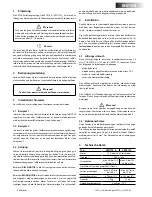
080105.02
3
vetus®
Extractor fan type VENT76_A / VENT102_
1 Introduction
The VETUS extractor fan type VENT76_A / VENT102_ is intended for ven-
tilating the engine room, toilet or kitchen.
W
arning
!
In order to prevent personal injury, the electrical supply should al-
ways be disconnected during installation and maintenance.
Never use the fan where the ambient temperature exceeds 70º C
(158 degrees F).
c
aution
We
DO NOT
recommend that this extractor fan is used to supply air to
the ship’s engine. Any engine will be able to supply itself with air, provid-
ed the ventilation openings in the engine room are large enough. When
a fan is fitted in the engine’s air supply duct, the suction of the engine
intake will make the fan run too fast, causing it to overheat.
2 Operating Instructions
The fan should be switched on for a minimum of 4 minutes and the en-
gine room checked for vapour before the engine is started.
W
arning
!
NEVER switch the fan on while refuelling.
3 Installation recommendations
The fan can be fitted in a number of different situations.
3.1 Example 1
Here, the ship’s engine does NOT obtain its inlet air separately. The en-
gine room can only be ventilated by the fan when the engine is stopped.
See Drawing 1.
3.2 Example 2
In this situation, the ship’s engine gets its inlet air separately (via a grille
with plenum chamber). The fan is then used to extract hot air from the
engine room. this can be done while the engine is running or stopped.
See Drawing 2.
3.3 Note
Always ensure that the ventilation openings are large enough, and that
the fan(s) has sufficient capacity. Improperly positioned ventilation open-
ings and insufficient capacity fans can lead to poor functioning of the
ship’s engine. Always read the engine supplier’s installation instructions.
With a
DIESEL engine
, the air should preferably enter the engine room
low down, and be extracted as high up as possible.
With a
PETROL engine
, the air should enter from high up in the engine
room, and be
extracted as low down as possible
, where it is most likely
that vapour will collect. This point should always be below the top of the
engine foundation. However, the duct opening should not be so low that
there is a risk of bilge water being sucked into the fan.
4 Installation
Fit the fan in a bulkhead or floor, high enough above the bilge
water level, in a place free from splashes, drips or deck swabbing
water.
Determine the position of the fitting holes. Use the fan as a guide.
Drill holes for 4.8 mm. (no. 10) screws. Fix the fan with the screws.
Tighten up the screws evenly,
but not so tight
that you split the
mounting feet.
4.1 Ventilation Duct
Fit ventilation ducting with an internal diameter of 76 mm (3”)
(VENT76_A) / 102 mm (4”) (VENT102_),which conforms to the fol-
lowing requirements:
- Smooth inside
- Resistant to a temperature of at least 70º C (158 degrees F)
- Resistant to water, oil and fuel
- Resistant to under and over-pressure
Keep the ventilation ducting as short as possible with as few
bends as possible. Keep the radius of any bends as large as pos-
sible.
Fit the duct with a screwing movement to the duct outlet. Fix
ducting with stainless steel hose clamps.
W
arning
!
Fit a grille over the extractor opening when the fan does not have
a ventilation duct. This will prevent touching the revolving fan
blades.
4.2 Electrical Connections
Check that the on-board voltage is the same as that stated on
the fan.
Connect the fan as shown in the diagram, see Drawing 3. Extend
the connector wires if required. Use wiring with a minimum core
cross-section of 2.5 mm
2
(AWG 14). Fit a fuse in the + wire.
5 Technical Data
Type
:
VENT76_A
VENT102_
Motor
:
12 V or 24 V direct current
Speed
:
4800 rpm
Current
:
Max. 8 A for 12 V;
4 A for 24 V
Max. 9 A for 12 V;
4.5 A for 24 V
The motor is ‘ignition protected’, ISO8846
Capacity
:
Max. 4 m
3
/min
(141 CFM)
for 13.6 V
Max. 8 m
3
/min
(282 CFM)
for 13.6 V
Duct connection
:
ø 76 mm (3”)
ø 102 mm (4”)
Weight
: 1.2 kg (2.65 lbs)
1.5 kg (3.30 lbs)
Ambient temperature :
Maximum 70 degrees C
(158 degrees F)
ENGLISH


























